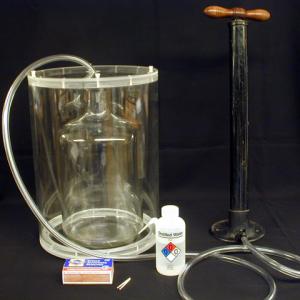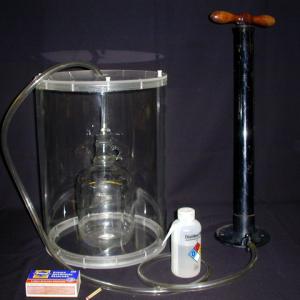College of Liberal Arts & Sciences
4B70.25 - Cloud in a Bottle
See also 4B70.25 in Astronomy.
Place a small amount of water in the bottom of the jug. Warm water will work a little better that cold. Light a match, wait for it to burn down, and then blow it out, and immediately drop it into the jug (The smoke will create the nucleation sites needed for the demo). Insert the stopper and twist it in fairly well. Pressurize the jug with the bicycle pump and when the stopper pops out the cloud will form.
An alternative is to use Isopropyl alcohol as the liquid. This seems to make a denser cloud. Put a small amount of the alcohol in the soda bottle and roll the bottle to distribute the alcohol onto the side walls of the bottle. Pressurize with the bicycle pump until the stopper pops out and the cloud forms. If you re-insert the stopper and pressurize the bottle again, the cloud will disappear until or when the stopper pops back out.
- Wheijen Chang, "Teaching the First Law of Thermodynamics via Real-Life Examples", TPT, Vol. 49, # 4, p. 231, April 2011.
- Mark Talmege Graham, "Cloud Formation", TPT, Vol. 42, # 5, May 2004, p. 301.
- "Figuring Physics", TPT, Vol. 35 # 1, Feb. 1997, p. 120.
- "Teaching Physics", TPT, Vol. 33, # 3, March 1995, p. 191.
- R.D. Russell, "Demonstrating Adiabatic Temperature Changes", TPT, Vol. 25, # 7, p. 450, Oct. 1987.
- James E. Kettler, "Experiment in a Coke Bottle",TPT, Vol. 17, # 5, May 1979, p. 321.
- H- 360: "Cloud in Jug - Pump Up Tire", DICK and RAE Physics Demo Notebook.
- M- 23b: Wallace A. Hilton, Physics Demonstration Experiments.
- Tik Liem, "A Cloud in a Bottle I and II", Investigation to Science Inquiry, p. 71.
- Charles Day, "Smoke From Burning Vegetation Changes the Coverage and Behavior of Clouds", Physics Today, May 2004, p. 24
- 50 Fun Experiments for the Mad Scientist in You, "Rain Clouds in a Bottle". National Geographic Kids, p. 75.
- Borislaw Bilash II, David Maiullo, "Pressing the Temperature", A Demo a Day: A Year of Physics Demonstrations, p. 235.
- Janice VanCleave, "20, Make Your Own Smog", Teaching the Fun of Physics, p. 30.
- Gordon L. Olson, "Making a Cloud in a Cheap Bottle", The Science Teacher, September 1989, p. 76.
- Brown, Science for You-112 Illustrated Experiments, p. 5.
- "Do It: A Cloud in a Jar", The Ben Franklin Book of Easy and Incredible Experiments.
- "Fog Chamber", Exploratorium Science Snackbook
- Janice VanCleave, "Bigger", 201 Awesome, Magical, Bizarre, & Incredible Experiments, p. 83.
- Janice VanCleave, "Drops", 201 Awesome, Magical, Bizarre, & Incredible Experiments, p. 82.
- "Smoke Blown Through Glass: Smoke and Vapors", Chemical Magic.
- Wellnitz, "Making a Cloud", Science in Your Backyard, p. 96- 97.
- Bobby Mercer, "Cloud in a Bottle", Junk Drawer Chem, 2016, p. 186.
Disclaimer: These demonstrations are provided only for illustrative use by persons affiliated with The University of Iowa and only under the direction of a trained instructor or physicist. The University of Iowa is not responsible for demonstrations performed by those using their own equipment or who choose to use this reference material for their own purpose. The demonstrations included here are within the public domain and can be found in materials contained in libraries, bookstores, and through electronic sources. Performing all or any portion of any of these demonstrations, with or without revisions not depicted here entails inherent risks. These risks include, without limitation, bodily injury (and possibly death), including risks to health that may be temporary or permanent and that may exacerbate a pre-existing medical condition; and property loss or damage. Anyone performing any part of these demonstrations, even with revisions, knowingly and voluntarily assumes all risks associated with them.


